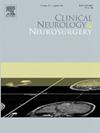Microstructural patterns in substantia nigra subregions are associated with depression and olfactory impairments in Parkinson’s disease
IF 1.8
4区 医学
Q3 CLINICAL NEUROLOGY
引用次数: 0
Abstract
Objective
Parkinson's Disease (PD) manifests with both motor and non-motor symptoms, with non-motor symptoms often appearing first. The link between non-motor symptoms, particularly depression, and olfactory dysfunction, and substantia nigra (SN) subregions has been studied less. By utilizing Diffusion tensor imaging (DTI), we investigated the associations between microstructural patterns in the SN’s subregions and motor and non-motor symptoms in patients with PD, including those without evident dopaminergic deficits, compared to healthy controls (HC).
Methods
Complete baseline demographic data, motor assessments, full-scale non-motor tests, and DTI of SN subregions for 260 participants, including 156 with PD, 36 with scans without evidence of dopaminergic deficit (SWEDD), and 68 HC, were extracted from the PPMI database. Multiple linear regression models were used to evaluate the associations between symptom scores and DTI findings.
Results
A significant difference in depression between the groups was found (p < 0.01), with patients with SWEDD having the highest rate of depression (approximately 36.1 %). Depressed SWEDD patients, compared to non-depressed ones, had higher FA values in the right rostral part of SN (p = 0.03, adjusted p = 0.15). Anxiety scores were significantly higher in both PD and SWEDD groups compared to HCs. PD patients exhibited a significantly higher prevalence of olfactory dysfunction compared to SWEDD and HCs (p < 0.001, adjusted p = 0.03), with 54.5 % of PD patients experiencing hyposmia and 34 % of them suffering from anosmia. PD patients with normosmia and hyposmia had higher FA in the right caudal SN than those with anosmia.
Conclusion
Our findings suggest significant brain microstructural differences in SN associated with depression and olfactory dysfunction in patients with PD with or without evident dopaminergic deficits. This finding highlights the advantage of DTI in detecting microstructural changes in patients with SWEDD.
求助全文
约1分钟内获得全文
求助全文
来源期刊

Clinical Neurology and Neurosurgery
医学-临床神经学
CiteScore
3.70
自引率
5.30%
发文量
358
审稿时长
46 days
期刊介绍:
Clinical Neurology and Neurosurgery is devoted to publishing papers and reports on the clinical aspects of neurology and neurosurgery. It is an international forum for papers of high scientific standard that are of interest to Neurologists and Neurosurgeons world-wide.
 求助内容:
求助内容: 应助结果提醒方式:
应助结果提醒方式:


